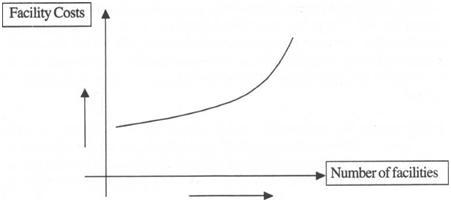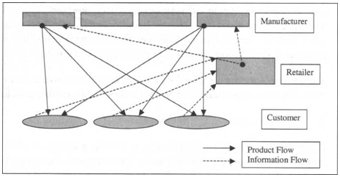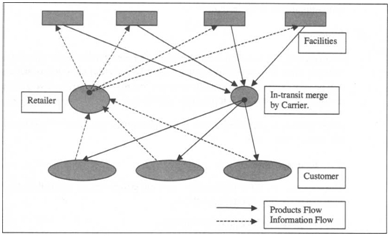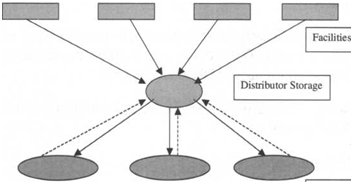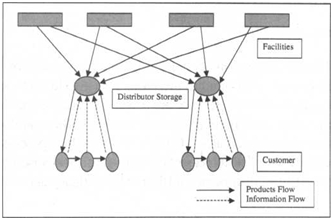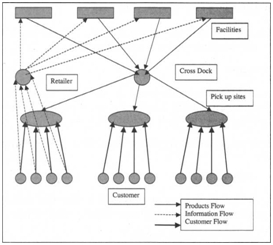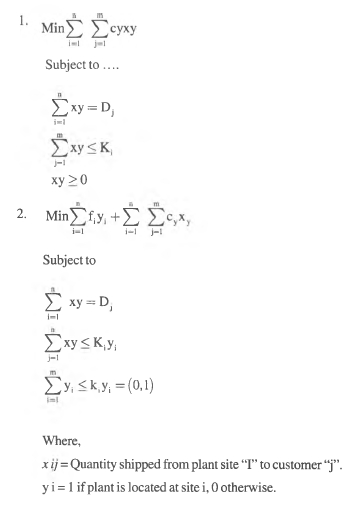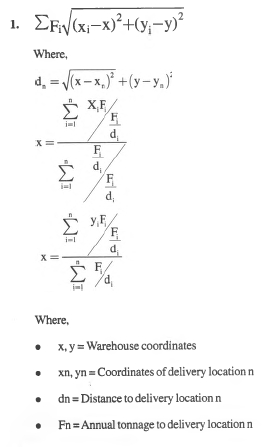Factors affecting the Distribution Network Design
Two major factors that deeply affect the distribution network design of any supply chain are –
- Meeting customer’s timely needs
- Costs involved in meeting the customer’s needs
Meeting the customer’s demands on time affect the revenues of the company at large, which along with the costs together affect the overall profitability of the network and the company as a whole. There are various components that affect both customer service and the distribution network at large.
- Response time
- Product variety
- Product availability
- Customer experience
- Order visibility
- Retumability
Figure below displays the relationship between the number of facilities and the desired response time
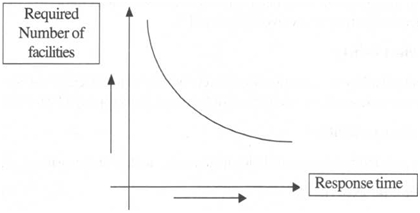 Effect on the inventory and inventory costs
Effect on the inventory and inventory costs
As the number of facilities in a supply chain increases, the inventory and the resulting inventory costs increase. In order to reduce the inventory costs, companies try to reduce the number of facilities and consolidate them in order to limit the number of facilities and thereby control their excess costs.
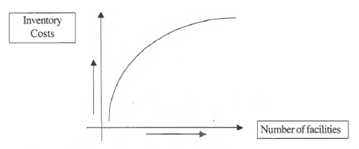 Effect on transportation costs
Effect on transportation costs
Transportation costs are of two types. These costs are called Inbound transportation costs and Outbound Transportation costs. Inbound transportation costs are those costs that are incurred while bringing the material into the company facility. On the other hand, outbound transportation costs are those that are incurred while sending the products outside the facility. It is observed that the inbound transportation costs are lesser than the outbound transportation ones because these include bringing of raw material that is in bulk, therefore the per unit transportation costs tend to decrease. On the other hand, the outbound transportation costs are higher because products may need to be transported in smaller lots to different locations and the cost per unit tends to be higher than the inbound transportation costs.
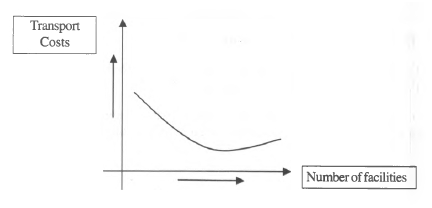 Effect on the facilities costs
Effect on the facilities costs
Facilities cost is nothing but the cost that is incurred in setting up a facility. Companies, in order to have an efficient and responsive supply chain, tend to alter the number of facilities depending on the situation. However, a company needs to consolidate its number of facilities in order to have a responsive and efficient supply chain. The number of facilities has a direct impact on the costs. An increase in the number of facilities will lead to an increase in the facility costs and vice versa.
We can say that for a supply chain network:
Total Logistics Cost = Inventory Costs + Transportation Costs + Facility Costs.
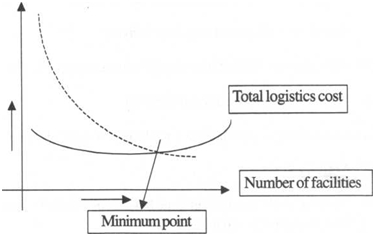 If a company wishes to improve on its response time more effectively, then it may increase the number of facilities, which would also lead to an increase in the total logistics costs after the minimum point. It is important to note that companies would like to exercise such increase in the number of facilities only if they are confident that the increase in revenues because of better responsiveness is more than the increase in the costs due to the additional facilities.
If a company wishes to improve on its response time more effectively, then it may increase the number of facilities, which would also lead to an increase in the total logistics costs after the minimum point. It is important to note that companies would like to exercise such increase in the number of facilities only if they are confident that the increase in revenues because of better responsiveness is more than the increase in the costs due to the additional facilities.
Different Distribution Network Design
Designing a distribution network is based on two important factors. These two factors are:
- Whether the product flow directly to the customer or flows through some intermediary
- Whether the product flow directly to the customer or flows through some intermediary.
After the company is clear about these two factors, they can choose the basic framework of any of the six most important designs of distribution networks. These are:
- Manufacturer storage with direct shipping – With the direct shipping design network, centralisation of inventories is possible for the manufacturer.
- Manufacturer storage with direct shipping and in-transit merge – The manufacturer storage with direct shipping and in-transit merge involves the combination of different pieces of an order that come from different manufacturers (different locations) so that the customer gets a single delivery.
- Distributor storage with package carrier delivery – This type of design option involves the storage of products with the retailer or distributor in their warehouses and not with the manufacturers as was the case with the direct shipping and in-transit merge design network options
- Distributor storage with last mile delivery – By ‘last mile delivery’ we mean that the distributor or retailer provides delivery of the demanded product up to the customer’s place. This delivery is made without using a carrier. It is very important to note that companies opting for the distributor storage with last mile delivery design option have their warehouses placed very close to the customer.
- Manufacturer/ Distributor storage with customer pick-up – This design option is comparatively a modem design network option and is used by most of the online or ‘dotcom’ companies as we call them. In this option, the manufacturer or the distributor holds inventories at their warehouses, but the customers place their order by phone, or on the internet, and then come to a designated place to collect the products ordered for.
- Retail storage with customer pick-up – Under the retail storage option, the inventory is stored at the retail outlets. Desirous customers may come to these retail outlets anytime and purchase the desired products. They may also apply online or call up any of the company’s hot line numbers to place their orders and then pick it up from a retail store.
Selecting a Network Design Options
A supply chain manager needs to keep in mind the following points before selecting any network design option:
- Consideration of product characteristics.
- The requirements of the network.
following table shall tell us which type of network design is best suited for a particular product.
Comparative Performance of options
| FACTORS | 8.3.1 | 8.3.3 | 8.3.2 | 8.3.5 | 8.3.4 | 8.3.6 |
| RESPONSE TIME | 4 | 3 | 4 | 4 | 2 | 1 |
| PRODUCT VARIETY | 1 | 2 | 1 | 1 | 3 | 4 |
| PRODUCT AVAILABILITY | 1 | 2 | 1 | 1 | 3 | 4 |
| CUSTOMER EXPERIENCE | 4 | 2 | 3 | 5 | 1 | 5 |
| ORDER VISIBILITY | 5 | 3 | 4 | 6 | 2 | 1 |
| RETURNABILITY | 5 | 4 | 5 | 2 | 3 | 1 |
| INVENTORY | 1 | 2 | 1 | 1 | 3 | 4 |
| TRANSPORTATION | 4 | 2 | 3 | 1 | 5 | 1 |
| FACILITY AND HANDLING | 1 | 3 | 2 | 5 | 4 | 6 |
| INFORMATION | 4 | 3 | 4 | 5 | 2 | 1 |
Manufacturer storage with direct shipping
- Distributor storage with carrier delivery.
- Manufacturer storage with direct shipping & in – transit merge.
- Manufacturer storage or Distributor storage with last mile delivery.
- Distributor storage with last mile delivery.
- Retail storage with customer pick – up.
Distributors in The Supply Chain: Indian Perspective
It has been a topic of hot debate whether distributors should exist in a supply chain or not. This is because it is said that having distributors in a supply chain badly affects the supply chain network. However in India, the distribution of all fast moving consumer goods and other electronic components takes place through distributors.
The role played by distributors in the distribution of Fast Moving Consumer Goods (FMCGs) and electronic components.
- Distributors add significant value to the supply chain if there are a large number of retailers involved in the supply chain.
- Distributors improve the performance of the supply chain by decreasing the transportation costs with the help of aggregation of the inbound shipment and the outbound shipment.
- Distributors also help in the reduction of inventory costs, by keeping safety buffers of inventory and stabilizing the flow of replenishment orders to the manufacturers.
Distributors prove excellent for the customer as they provide better customer experience, a one-stop shop for all purchases and also reduce the response time as compared to the manufacturers.
Network Design in a Supply Chain
An effective network design should be able to answer the following questions:
- What roles do the facilities play and what are the processes performed by them?
- Where must these facilities be located?
- Which markets shall these facilities serve?
- How much capacity shall these facilities be allocated so as to perform consistently ?
Once a facility is clear about these decisions, then it is very easy for them to perform consistently and become all the more “Flexible” in their operations.
Capacity allocation has a significant impact on the supply chain’s performance. This is because capacity of any facility can be altered easily as compared to the location of the facility. However, even these decisions need to be made correctly, as proper allocation of capacity to a facility helps to maintain or reduce costs and thereby optimum utilisation of the facility can be achieved. But, if more capacity is allocated to a facility or even less capacity is allocated, then it becomes difficult for a company to satisfy the demand of the customers that are closer or further from the facility.
The allocation of the various supply sources and also the allocation of particular markets for a particular facility has a significant impact on the supply chain performance. This in turn it affects the production and transportation costs and also the inventory that a supply chain must serve in order to satisfy the customer demand. Thus, this decision must be reviewed from time to time so that the allocation of capacity, markets and supply sources can be altered as and when the demand arises.
The whole supply chain configuration can be altered on the basis of the decisions made on the supply chain network design. These decisions also help to prepare restrictions within which the inventories, transportation and most importantly, information can be utilised to increase or decrease the supply chain responsiveness and the supply chain costs.
*These decisions can help a company figure out which facility performs better, is cheaper for them or is more responsive to its customers and how these facilities will work for the future.
Models for Activity and Capacity Allocation
Maximizing the company’s overall profits and being highly responsive by providing the desired products and services on time to the customers, should be the main objective of any supply chain manager of a firm. The sale of the products and services generate revenue; whereas the labour, facilities, inventory, material and transportation are factors that give rise to costs. The taxes applicable and other tariffs also hinder the profits of a Arm. Thus, every supply chain manager must aim at increasing profits after minimising taxes and tariffs.
The following information should be studied by the manager before taking any network design decisions:
- Location of the sources of supply and the markets to be served
- Location of the potential facilities
- Demand of the markets
- Total costs at each of the sites. (Fixed / Variable)
- Transportation costs between the sites
- Inventory costs
- Sale prices of products at every location
- Taxes and tariffs, if goods are moved from one location to another
- Desired response time
With respect to the above available information, either Network optimization models or Gravity Location models can be used to decide the supply chain network design.
Network optimisation models
The Network optimisation models can be used in the second step of deciding the network design. In this step we know that the supply chain manager considers the regional demand, the tariffs, taxes and all the factor Costs in order to decide whether a specific location is satisfactory for locating a facility and allocating a Specified capacity.
The use of the following formulae can be made in order to decide upon the demand allocation to a facility and allocation to a facility and also the location of plants with multiple sourcing facilities. Thus this model helps us to decide which plants are to be established and how to configure the supply chain network
- Which market is served by which plant?
- Which supply sources are used by a plant?
Gravity location models
Gravity location models help to do just this. It helps managers to decide upon the suitable geographical locations within the region for the development of a plant facility. These models help the company to reduce the transportation costs involved in bringing the raw material from the suppliers and delivering the finished products to the markets. The gravity location models assume that both the markets and the supply sources are located as grid points on a plane. Thus, in this model all the distances are geometric in nature and depict the distance between any two points on a plane.


